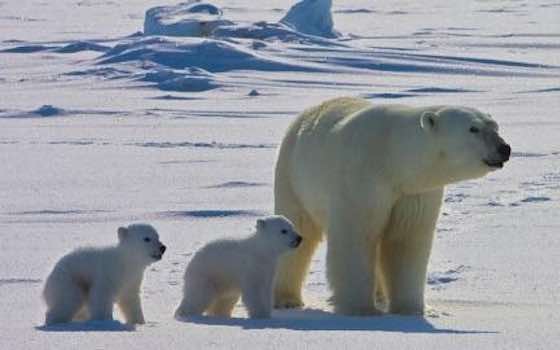- MENU
- HOME
- SEARCH
- WORLD
- MAIN
- AFRICA
- ASIA
- BALKANS
- EUROPE
- LATIN AMERICA
- MIDDLE EAST
- United Kingdom
- United States
- Argentina
- Australia
- Austria
- Benelux
- Brazil
- Canada
- China
- France
- Germany
- Greece
- Hungary
- India
- Indonesia
- Ireland
- Israel
- Italy
- Japan
- Korea
- Mexico
- New Zealand
- Pakistan
- Philippines
- Poland
- Russia
- South Africa
- Spain
- Taiwan
- Turkey
- USA
- BUSINESS
- WEALTH
- STOCKS
- TECH
- HEALTH
- LIFESTYLE
- ENTERTAINMENT
- SPORTS
- RSS
- iHaveNet.com: Environment

The Arctic ice is shrinking and polar bears are suffering the consequences.
The Arctic region is undergoing significant changes due to global warming and climate change. While it is true that the Arctic is experiencing warmer temperatures, it is incorrect to say that the Arctic is no longer cold enough for polar bears. Here are some key points to consider:
Polar Bears' Adaptations
Polar bears are well-adapted to living in cold environments and have evolved various physiological and behavioral adaptations to survive in the Arctic. Their thick layer of blubber, dense fur, and small ears help them retain heat. They also have specialized adaptations, such as a layer of insulating fat beneath their skin and hollow hairs that provide buoyancy and insulation.
Sea Ice Dependence
Polar bears rely on sea ice as a platform for hunting seals, their primary prey. The Arctic sea ice provides a habitat for polar bears to travel, hunt, mate, and den. As the sea ice melts and retreats due to climate change, polar bears face challenges in accessing their food sources and maintaining their population.
Impacts of Sea Ice Loss
The decline in Arctic sea ice reduces the amount of time polar bears have on the ice for hunting and feeding. They are forced to swim longer distances to find suitable ice, leading to increased energy expenditure and the potential for population decline. Additionally, reduced sea ice cover limits their ability to find suitable denning sites for breeding and raising their young.
Conservation Concerns
The decreasing availability of sea ice has raised conservation concerns for polar bears. The International Union for Conservation of Nature (IUCN) lists polar bears as vulnerable due to the ongoing loss of their sea ice habitat.
It is important to note that while polar bears face significant challenges due to climate change, they still inhabit the Arctic and are adapted to survive in cold environments. Efforts are being made to monitor and protect their populations, including implementing measures to reduce greenhouse gas emissions and conserving their habitat.
However, continued global efforts to mitigate climate change and reduce greenhouse gas emissions are crucial to ensuring the long-term survival of polar bears and the preservation of their Arctic ecosystem.
More Environment & Climate Change ...
- 5 Radical Takeaways from the Pope's Letter on Climate
- A Green-Energy Founding Father
- We're All Taking Dirty Pictures
- Faking It While the World Burns
- This Oil Spill Hits Close to Home
- A Fossil-Fueled Fantasy
- The Pentagon Makes War on Alaska's Pristine Wilderness
- Climate Denial Syndrome Sweeps Wisconsin
- How Climate Change and Resource Scarcity Are Upending World Politics
- Virginia Is for Dirty-Energy Lovers
- Humanity's War on Wildlife
- Making Green Cool Again in Hungary
- David and Goliath in the Amazon
- NASA Warns of 'Megadroughts'
- Our Growing Carbon Emissions
- Global Warming Triggered Syria War
- Round-the-World Solar Flight Takes Off
- 10 Extreme Weather Facts
- New York City Sea Level Rises
- Alaskan Glaciers Disappearing
- Leather Sludge New Bio-Fuel Source
- Why the Ocean is Turning More Acidic
- Why Whales Beach Themselves
- Termites Fight Climate Change
- Gas-Guzzlers On Road To Extinction
- Technology & Transformation
- Ecuador: All You Need Is Love and Oil?
- China Pulls Critical Pollution Documentary Offline
- Forging Our Future
- Green Believers
- The Glaciers Are Talking to Us
- Bald Eagles Nesting In New York City For First Time In 100 Years
- Asian Pollution Messing With U.S. Weather
- Instagram Account Shows Reality of Climate Change
- Keystone Pipeline Would Emit Tons of Greenhouse Gases
- Why You Can't Throw Away Batteries
- Road Salt Is Worse Than You Think
- Arctic Not Cold Enough for Polar Bears
- Doomsday Clock & Climate Change
- Sea-Level Accelerating Faster Than Previously Thought
- 6 Countries Dictate Planet's Future
- Manhattan Size Glacier Breaks Apart
- Opinions Split on Fracking Benefits
- Bad News for Sea Level Rise
- 2014 Hottest Year On Record According To NASA
- While Our Planet Melts, GOP Pleads Ignorance
- The Myth of the Wild
- Plastic Bags are Not a Need - Just a Bad Habit
- Environmental Security: Conflict or Cooperation?
- Beyond The Water-Food-Energy-Climate Nexus
- Climate Change Report Sounds Alarm for Planet Earth
- Genesis, Mother Nature and Environmental Stewardship
- Global Climate Change: Calling All Pagans
- Chicken Little 'Science'
- Climate Change and Interstate Conflict
- Fracking: A Deadly Power Surge
- Inhospitable Earth -- Compared to What?
More Environment & Climate Change ...
"The Arctic Isn't Cold Enough for Polar Bears Anymore "